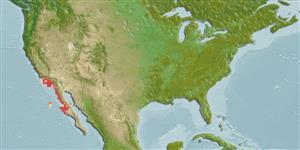>
Ovalentaria/misc (Various families in series Ovalentaria) >
Pomacentridae (Damselfishes) > Microspathodontinae
Etymology: Hypsypops: Greek, hypsy, hypops = high + Greek, ops = appearance (Ref. 45335).
More on author: Girard.
Environment: milieu / climate zone / depth range / distribution range
Ökologie
seewasser riff-verbunden; standorttreu; tiefenbereich 0 - 30 m (Ref. 9334). Subtropical; 37°N - 27°N, 122°W - 114°W
Eastern Central Pacific: Monterey Bay in California, USA to southern Baja California and Guadalupe Island (off northern central Baja California) in Mexico.
Size / Gewicht / Alter
Maturity: Lm ? range ? - ? cm
Max length : 30.0 cm SL Männchen/unbestimmt; (Ref. 7247); max. veröff. Alter: 57 Jahre (Ref. 52465)
Rückenflossenstacheln (insgesamt): 12; Rückenflossenweichstrahlen (insgesamt): 16-17; Afterflossenstacheln 2; Afterflossenweichstrahlen: 13 - 14
Adults occur over rocky bottom in clear water, often near crevices and small caves, occasionally in kelp. Adults defend a home territory. Feed mainly on attached invertebrates. Oviparous, distinct pairing during breeding (Ref. 205). Eggs are demersal and adhere to the substrate (Ref. 205). Males guard and aerate the eggs (Ref. 205). Have been reared in captivity (Ref. 35420).
Oviparous, distinct pairing during breeding (Ref. 205). Male clears a sheltered nest site; female deposits eggs, which male guards (Ref. 2850).
Allen, G.R., 1991. Damselfishes of the world. Mergus Publishers, Melle, Germany. 271 p. (Ref. 7247)
IUCN Rote Liste Status (Ref. 130435)
Bedrohung für Menschen
Harmless
Nutzung durch Menschen
Mehr Information
ReferenzenAquakulturAquakultur ProfilZuchtlinienGenetikElectrophoresesVererbbarkeitKrankheitenVerarbeitungNutrientsMass conversion
Tools
Zusatzinformationen
Download XML
Internet Quellen
Estimates based on models
Preferred temperature (Ref.
123201): 15.3 - 19.2, mean 17.5 °C (based on 48 cells).
Phylogenetic diversity index (Ref.
82804): PD
50 = 1.0000 [Uniqueness, from 0.5 = low to 2.0 = high].
Bayesian length-weight: a=0.01950 (0.00922 - 0.04124), b=3.00 (2.82 - 3.18), in cm total length, based on LWR estimates for this (Sub)family-body shape (Ref.
93245).
Trophic level (Ref.
69278): 3.2 ±0.39 se; based on food items.
Generation time: 6.5 (5.8 - 7.3) years. Estimated as median ln(3)/K based on 28
growth studies.
Widerstandsfähigkeit (Ref.
120179): niedrig, Verdopplung der Population dauert 4,5 - 14 Jahre. (tmax=20; tm=5).
Fishing Vulnerability (Ref.
59153): Moderate to high vulnerability (51 of 100).
Nutrients (Ref.
124155): Calcium = 31.5 [13.7, 58.8] mg/100g; Iron = 0.521 [0.293, 0.911] mg/100g; Protein = 19.1 [17.9, 20.3] %; Omega3 = 0.148 [0.084, 0.258] g/100g; Selenium = 12.9 [6.1, 28.0] μg/100g; VitaminA = 48.5 [12.4, 190.6] μg/100g; Zinc = 0.866 [0.555, 1.315] mg/100g (wet weight);
